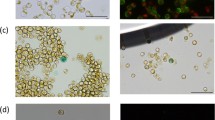Abstract
An efficient nuclear transformation method has been established for the pennate marine diatom Phaeodactylum tricornutum using an electroporation system that drives multisequence pulses to introduce foreign DNAs into the cells. By removing excess salts in the culture medium and optimizing pulse conditions, diatom cells can be transformed with high transformation efficiency. This method is also applicable to other marine diatoms, such as the centric diatom Chaetoceros gracilis. This efficient and stable transformation system will be useful for both functional analysis of diatom-specific genes and for further biotechnological applications.
Access this chapter
Tax calculation will be finalised at checkout
Purchases are for personal use only
Similar content being viewed by others
References
Falkowski PG, Barber RT, Smetacek VV (1998) Biogeochemical controls and feedbacks on ocean primary production. Science 281:200–207
Prihoda J, Tanaka A, de Paula WB, Allen JF, Tirichine L, Bowler C (2012) Chloroplast-mitochondria cross-talk in diatoms. J Exp Bot 63:1543–1557
Levitan O, Dinamarca J, Hochman G, Falkowski PG (2014) Diatoms: a fossil fuel of the future. Trends Biotechnol 32:117–124
Wang Y, Cai J, Jiang Y, Jiang X, Zhang D (2013) Preparation of biosilica structures from frustules of diatoms and their applications: current state and perspectives. Appl Microbiol Biotechnol 97:453–460
Zaslavskaia LA, Lippmeier JC, Kroth PG, Grossman AR, Apt KE (2000) Transformation of the diatom Phaeodactylum tricornutum (Bacillariophyceae) with a variety of selectable marker and reporter genes. J Phycol 36:379–386
Poulsen N, Chesley PM, Kroger N (2006) Molecular genetic manipulation of the diatom Thalassiosira pseudonana (Bacillariophyceae). J Phycol 42:1059–1065
Miyagawa-Yamaguchi A, Okami T, Kira N, Yamaguchi H, Ohnishi K, Adachi M (2011) Stable nuclear transformation of the diatom Chaetoceros sp. Phycol Res 59:113–119
Miyahara M, Aoi M, Inoue-Kashino N, Kashino Y, Ifuku K (2013) Highly efficient transformation of the diatom Phaeodactylum tricornutum by multi-pulse electroporation. Biosci Biotechnol Biochem 77:874–876
Ifuku K, Yan D, Miyahara M, Inoue-Kashino N, Kashino Y (2015) A stable and efficient transformation system for the diatom Chaetoceros gracilis. Photosynth Res 23:203–211
Tokushima H, Inoue-Kashino N, Nakazato Y, Masuda A, Ifuku K, Kashino Y (2016) Advantageous characteristics of the diatom Chaetoceros gracilis as a sustainable biofuel producer. Biotechnol Biofuels 9:235
Guillard RRL (1975) Culture of phytoplankton for feeding marine invertebrates. In: Smith WL, Chanley MH (eds) Culture of marine invertebrate animals. Springer, Boston, MA
Kajikawa M, Abe T, Ifuku K, Furutani KI, Yan D, Okuda T, Ando A, Kishino S, Ogawa J, Fukuzawa H (2016) Production of ricinoleic acid-containing monoestolide triacylglycerides in an oleaginous diatom, Chaetoceros gracilis. Sci Rep 6:36809
Acknowledgments
This work was supported by the Japan Science and Technology Agency, Advanced Low Carbon Technology Research and Development Program to K.I. (JPMJAL1105).
Author information
Authors and Affiliations
Corresponding author
Editor information
Editors and Affiliations
Rights and permissions
Copyright information
© 2020 Springer Science+Business Media, LLC, part of Springer Nature
About this protocol
Cite this protocol
Ifuku, K., Yan, D. (2020). Efficient Transformation of the Diatoms Phaeodactylum tricornutum by Multipulse Electroporation. In: Li, S., Chang, L., Teissie, J. (eds) Electroporation Protocols. Methods in Molecular Biology, vol 2050. Humana, New York, NY. https://doi.org/10.1007/978-1-4939-9740-4_18
Download citation
DOI: https://doi.org/10.1007/978-1-4939-9740-4_18
Published:
Publisher Name: Humana, New York, NY
Print ISBN: 978-1-4939-9739-8
Online ISBN: 978-1-4939-9740-4
eBook Packages: Springer Protocols




